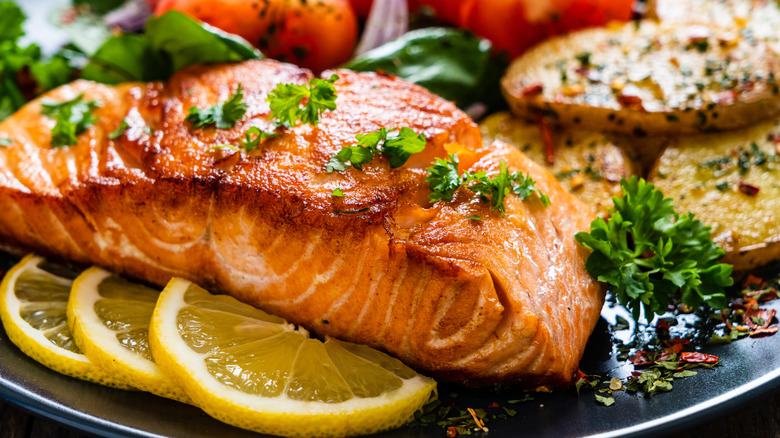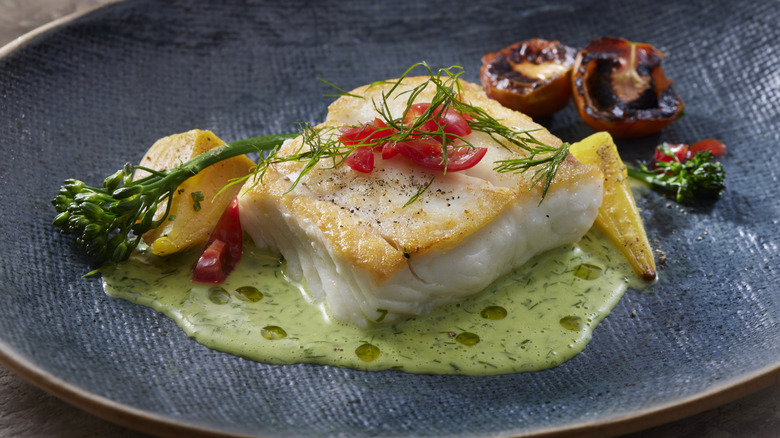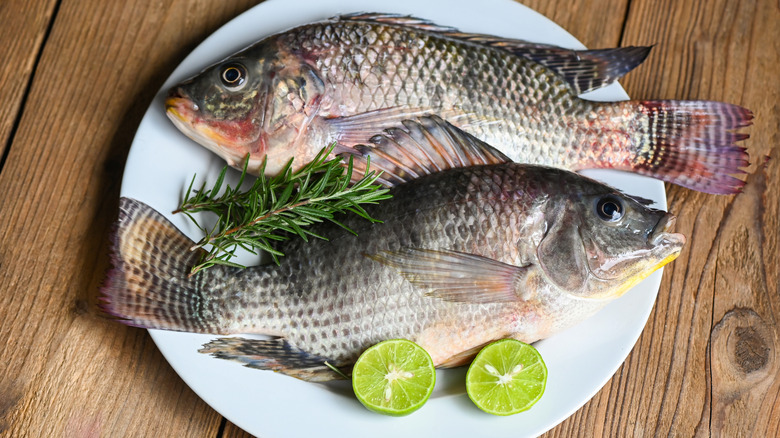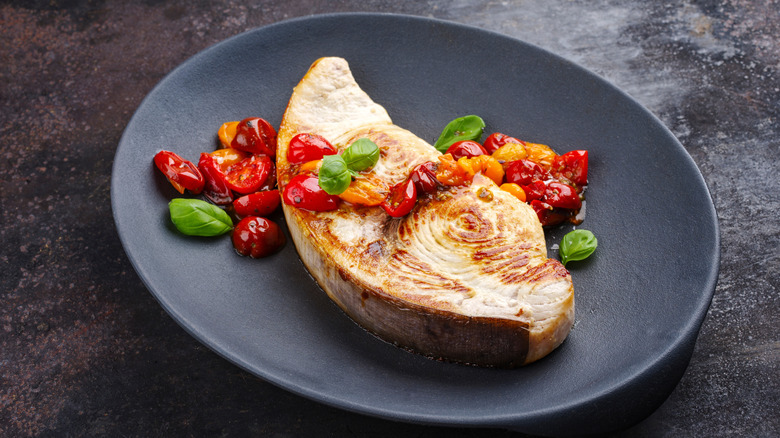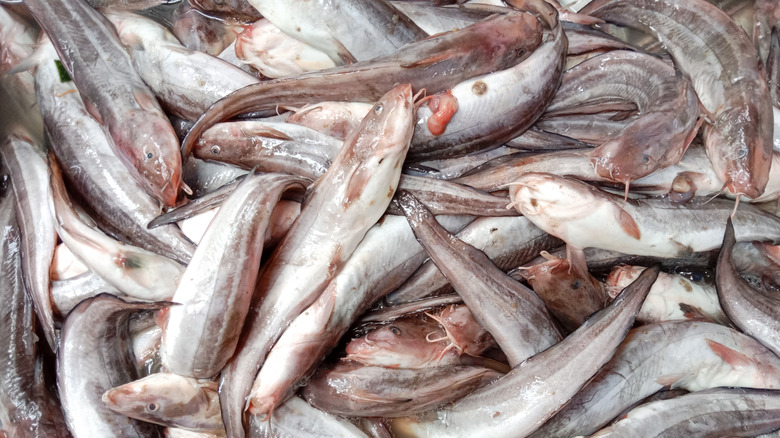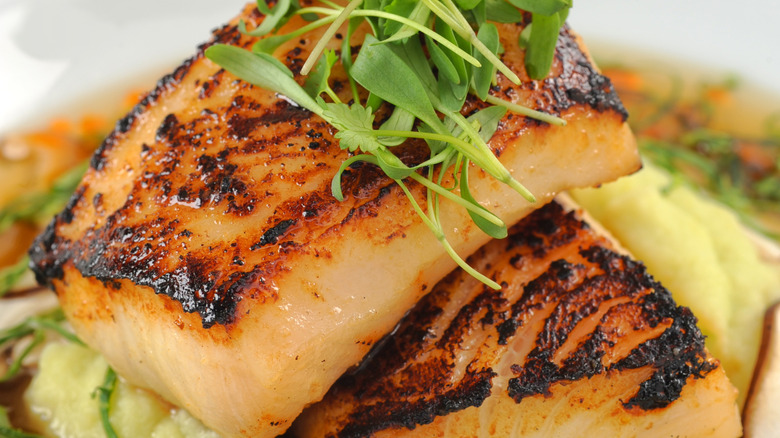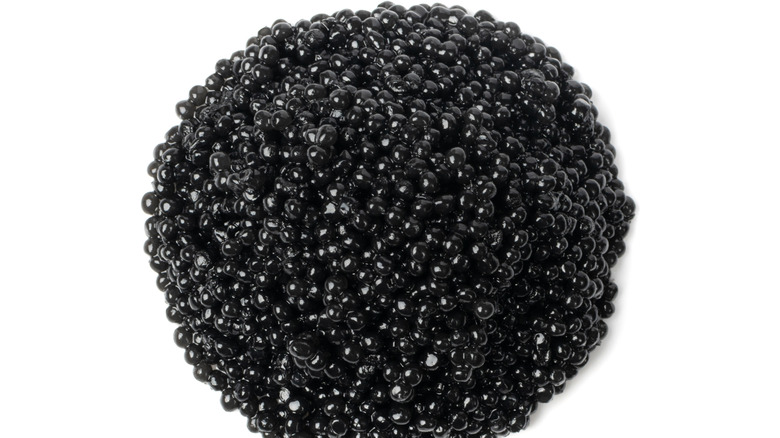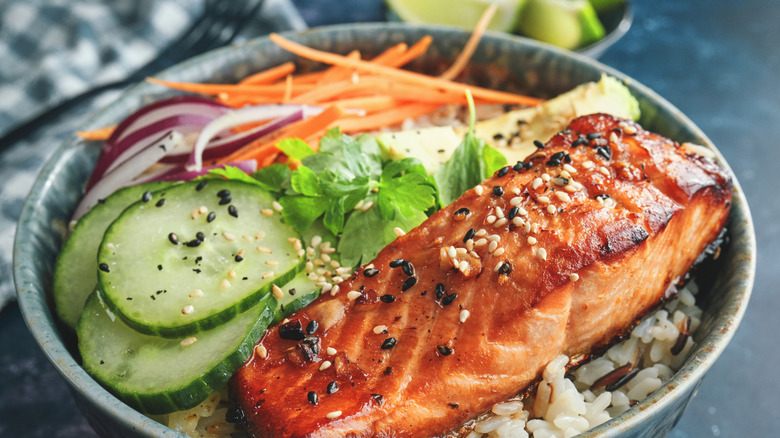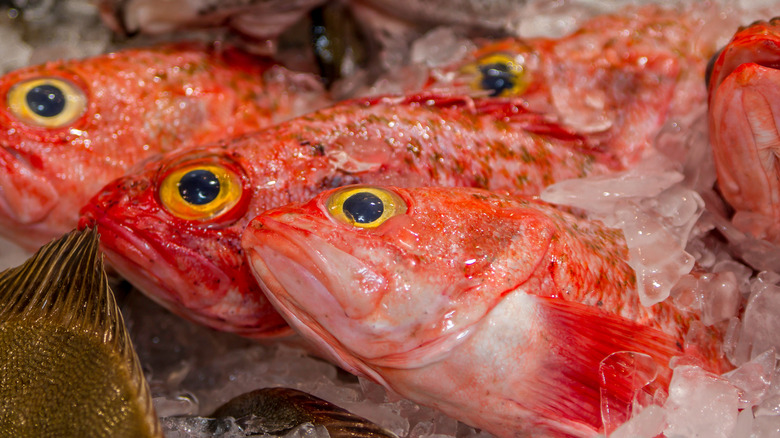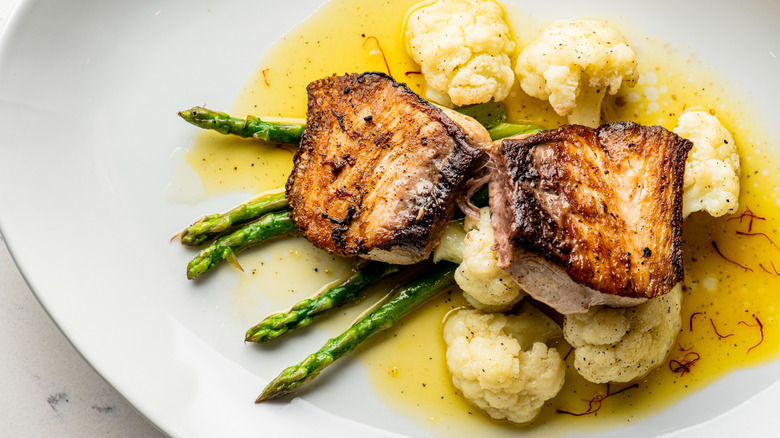A Seafood Chef Wouldn't Eat These 5 Fish & The 5 To Eat Instead
When fish is properly prepared, it's one of the most delicious parts of any meal. Yet when you purchase fish, how do you know which type to buy? And more important, how do you know if it's really fresh? Longtime chef and restaurateur Douglas MacMillan knows. With more than 36 years in the restaurant business, he and his wife Shannon currently own Ada's Fish House in Pismo Beach, California, where Douglas is executive chef. They also own Vista Steak and Seafood, which they opened in 2021, and family restaurant Rosa's Italian Restaurant, both in Pismo Beach. MacMillan insists that cooking fish is easy; that it's like anything else and involves a learning process.
"When people think of a chef, they think we have some magical wand," he says. "Cheffing is just understanding temperatures and what you're able to do, just as if you're practicing a sport." He also advises creating rapport with the people selling you the fish. "A sense of trust," he advises.
Once you're confident about preparation, you'll want to eat fish frequently. And now you can. In addition to living in a town on the Pacific Coast, MacMillan also has family ties to the East Coast and incorporates both styles of preparing fish in his restaurants. Those dining at his restaurants may order Atlantic-style lobster rolls or spiny lobster caught off the California coastline. Here are six types of fish he recommends, along with serving suggestions — and five types you might want to avoid.
Best: Halibut
Halibut is simply the star, chef Douglas MacMillan says. It's firm, mild, and not difficult to cook. "I'm not going to put anything on it that takes away from the star," he says. "Baked with lemon and seasoning, it's delicious. Or you can use tomato and basil."
One of the reasons halibut is a favorite for many fish lovers is the fat content, which makes it a little more forgiving if you cook it longer than you intended. "The colder the water, the higher the fat content of the fish," MacMillan explains. The flavor and preparation possibilities make it a favorite for both new and experienced cooks. "Low and slow" is the way MacMillan likes to cook this white, flaky fish. You might serve it grilled with fresh asparagus and cherry tomatoes. Poach it in wine and then use the poaching liquid as the basis of a sauce. Or, for a special occasion, you might crush some hazelnuts, reach for the chili powder, turmeric, and coconut milk, and create a nut-crusted halibut with green onion sauce. It's the perfect first-time fish for kids or for anyone who is not an experienced seafood eater.
When buying halibut or any fish, trust your nose. The aging process starts once the fish is filleted. If it smells "off" or has a smell similar to vinegar, you need to pass on the fish. As always, it's important to purchase fish from a trusted source.
Worst: Tilapia
There are those who sing the praise of tilapia, yet with the many fish from which to choose, chef Douglas MacMillan suggests taking care with this one. "I've never sold it," he says, "never bought it." A relatively inexpensive fish, tilapia is farmed in more than 135 countries all over the world, with China being the largest producer. Many are concerned about farming practices in some countries where there are fewer regulations about how fish are raised and what they eat. "Don't waste your money," MacMillan advises. "It's like a poor cut of meat. I don't think it has much of a flavor profile. I don't trust where it's coming from."
Our culture already consumes too many omega-6 fatty acids, which are linked to everything from to arthritis to heart disease — and imported tilapia contains high levels of them.
MacMillan also warns not to buy any fish that isn't sustainable. "Sustainable is not the fish," he says, "it's the way the fish is caught." Sustainable fish are harvested in ways that don't harm the environment. They are harvested at a rate that protects the quantity of fish still remaining. "You've got to know where you're buying," MacMillan says.
Best: Swordfish
Do you know someone who isn't sure whether they like fish? Someone who says it looks fine, but they'd just as soon have steak or a burger, thank you? There's only one way to convince that person, and that's by serving them stellar seafood. If you're looking for a "gateway fish" that will appeal to almost anyone, chef Douglas MacMillan recommends swordfish. "I call it the steak fish," he says. "I like to grill it like a steak. Cook it right on the grill." Do that, and you can convince just about any steak lover to widen their culinary horizons.
Like marlin, swordfish are technically billfish, and they're large — they can get up to 14 feet long and weigh 1,200 pounds.
MacMillan likes to baste the fish with a little butter and Worcestershire sauce. Firm, fleshy fish like this can stand up to the heat. Serve it right off the grill, or get creative with a topping. Our swordfish with mango salsa recipe adds a little heat with red pepper, tomato, onion, and cilantro, along with the sweet taste of the juicy mango. You might also top your swordfish with pesto, either purchased or freshly made. A refreshing dill pesto is the perfect complement to this hearty fish. If you want a break from grilling, sear the fish in wine sauce or cut it into kebabs and stick them under the broiler.
Worst: Imported catfish
Long before it became a term for deceiving a potential online love interest about your identity, catfish was just a fish. Many of the cooking methods, including marinating the fish in buttermilk and frying it, came from where the fish did — the southern part of the United States, primarily Mississippi. Of the more than 2,000 species of these fish in the world, the channel catfish and blue catfish are most often sold in the U.S. As is the case for all fish and shellfish in the U.S., catfish must be labeled according to their country of origin.
In March of 2024, the USDA issued a public health alert for imported catfish that were ineligible for U.S. entry. The fish, illegally imported from the People's Republic of China, were declared unfit for human consumption. In the U.S., fish are inspected for filth, and that inspection is mandatory. The ponds they're grown in are environmentally controlled. However, the same can't be said for imported catfish. If you're craving a Southern meal, and nothing but fried catfish with tartar sauce and all the trimmings will do, be sure to avoid imported catfish and stick to domestic, farm-raised catfish, which are readily available.
Best: Chilean sea bass
Chilean sea bass is not really a bass and not really from Chile, although Chileans introduced it to the U.S. This flaky, deep-water fish caught near Antarctica is also known as icefish and Patagonian toothfish, among other names, and you can see why Chilean sea bass stuck. It is one of chef Douglas MacMillan's favorites because it's not only full of flavor, but because it's also so easy to prepare. Worried that it will dry up on the grill? Not this fish. Concerned that it can't stand up to heavy heat? No worries. Wondering if you should bake, broil, or grill it? All of the above. That's how versatile and delicious Chilean sea bass is. You can even cook it in the air fryer.
"This is the most idiot-proof fish," MacMillan says. "It has the most fat, and you can't overcook it." Grilled Chilean sea bass with garlic butter sauce gets some heat from red pepper flakes and a Mediterranean vibe from capers and lemon. You can also broil it, top with fresh herbs, and serve on a bed of polenta. Because of the fish's high oil content, it has a buttery texture; even after cooking, it remains moist. The fish also takes well to Asian flavors and its sweetness is enhanced with a marinade of soy sauce, miso paste, and wine.
Worst: Wild caviar
It's a special occasion, and you've planned it down to the unsalted crackers, the crème fraîche, the Champagne, and the chilled vodka — all that's missing is deciding which caviar variety best works as the star of your presentation. But before you reach for the wild caviar, consider this. The United States restricts imported Beluga and other types of caviar, so if you've managed to score some, you have no idea where it originated or if its environment of origin is polluted. (There's a good chance that it is.) Don't waste your elegant feast on black-market caviar or caviar that is susceptible to overfishing. Consider buying your caviar from farm-raised sturgeon. These fish are sustainably raised, and you can be sure that the aquaculture they're brought up in meets the standards for legal trade.
Then, you can relax. Once that caviar is thoroughly chilled, get out the special spoons (remember, no metal spoons for scooping caviar) and enjoy your spread instead of worrying about whether you're consuming substandard seafood. As an alternative, you can eat caviar in less traditional but deliciously unique ways, such as tucked into lox and bagels, scooped onto potato chips, or even spooned into grilled cheese sandwiches and tacos.
Best: Salmon
There are times you're in the mood for fish, and then there are times when nothing will do but a perfect piece of salmon. Several health outlets have named it one of the healthiest types of fish to eat, and its succulent, satisfying flavor — rich but not "fishy" — makes it the perfect option for simple grilling and health-conscious dishes like fish and rice bowls. Conversely, you can go fancy with it. Combine cherry tomatoes, salmon fillets, and dill to create a majestic salmon en papillote. Looking for elegance? Poach the salmon and serve it with a wine sauce made from the cooking liquid. In a hurry? Sprinkle it with your favorite seasons, top it with slices of lemon, and bake. Fifteen minutes later, you'll have dinner. Have leftovers? Make salmon tacos and top them with a pineapple or mango salsa.
Chef Douglas MacMillan likes fresh Alaska coho salmon. "It's like the wild west up there (in Alaska)," MacMillan says. "The fish has a little more fat on it. The flavors are more in-depth. It's just a gorgeous fish." A little more fat means the fish is also a little more forgiving of high heat and a little less likely to dry out when you cook it.
Worst: Orange roughy
Orange roughy, which is also known as red roughy and by the less attractive name slimehead, used to show up much more frequently on menus and in markets than it does today. The fish was popular because of its mild taste and firm texture and was versatile enough to bake, pan-sear, or barbecue. Before you purchase it, know that you're probably buying a very old fish. Some of them live to be up to 150 years old. That means that fish has had plenty of time to absorb its share of mercury and other toxins, which will be passed onto you if you eat it.
This, coupled with orange roughy's slow reproduction cycle and the fact that it's overfished, has caused some environmental groups concern about its sustainability. In orange roughy's heyday, the fish was caught using trawl nets to take advantage of the fish's propensity for hanging out in groups. These nets damaged the sea floor and also ensnared other creatures, and the large hauls didn't give the fish enough time to replenish. Even without the sustainability concerns, the orange roughy still isn't the best choice if you're concerned about ingesting mercury. Choose from the many other tender, firm-fleshed fish that offer fewer negatives.
Best: Pacific red snapper
Yelloweye rockfish, better known as Pacific red snapper, is a versatile seafood chef Douglas MacMillan serves frequently at his restaurants in Pismo Beach, CA. "I pan-sear one side," he says. "It's a little firmer than halibut. I use it for fish sandwiches and rockfish bowls, too."
In a world of lobster rolls and fish tacos, the fish sandwich is often overlooked or dismissed as only a fast-food menu item. Yet there's something deeply satisfying about creating your own fish sandwich, and Pacific red snapper is a perfect option. Dip the fish in seasoned flour and bread crumbs, cook in hot oil until you have a crispy exterior, blot any remaining oil, and serve in your favorite bun. And don't forget the homemade tartar sauce.
MacMillan also serves Pacific red snapper pan seared with avocado and lime over brown rice. Sweet, nutty, and flaky, Pacific red snapper adapts to most cooking methods. Coat it in paprika, black pepper, and garlic powder, and then blacken it in a mixture of butter and oil. Bake it with lemon and garlic. Use it as the fish in fish and chips. Or go all out and grill whole red snapper with a ponzu sauce made of rice vinegar, sake, soy sauce, and mirin. The ponzu sauce will add a lemon-soy accent to this Asian dish.
Worst: American eel
American eels, also known as Anguilla rostrata, are like some people; they'll eat anything. Fish, insects, worms, frogs — you name it, and this eel probably considers it gourmet fare. Yet, eel is a popular addition to any number of dishes, including sushi and poke bowls.
In the past, pickled, smoked, and baked eel were far more common — and far more popular choices than they are today. Tastes have changed, however, and fewer people are consuming eel. Some people are turned off by the eel's slithery appearance, but that's not why many oppose serving or eating this eel. From the 1980s to 2021, the eel harvest shrunk from up to 3.6 million pounds annually to 427,048 pounds. In 2014, the American eel made it to "endangered" status on the International Union for the Conservation of Nature's Red List. While eels are not your best dining choice, they are important to the environment, so pass them by and consider other options for your sushi.

